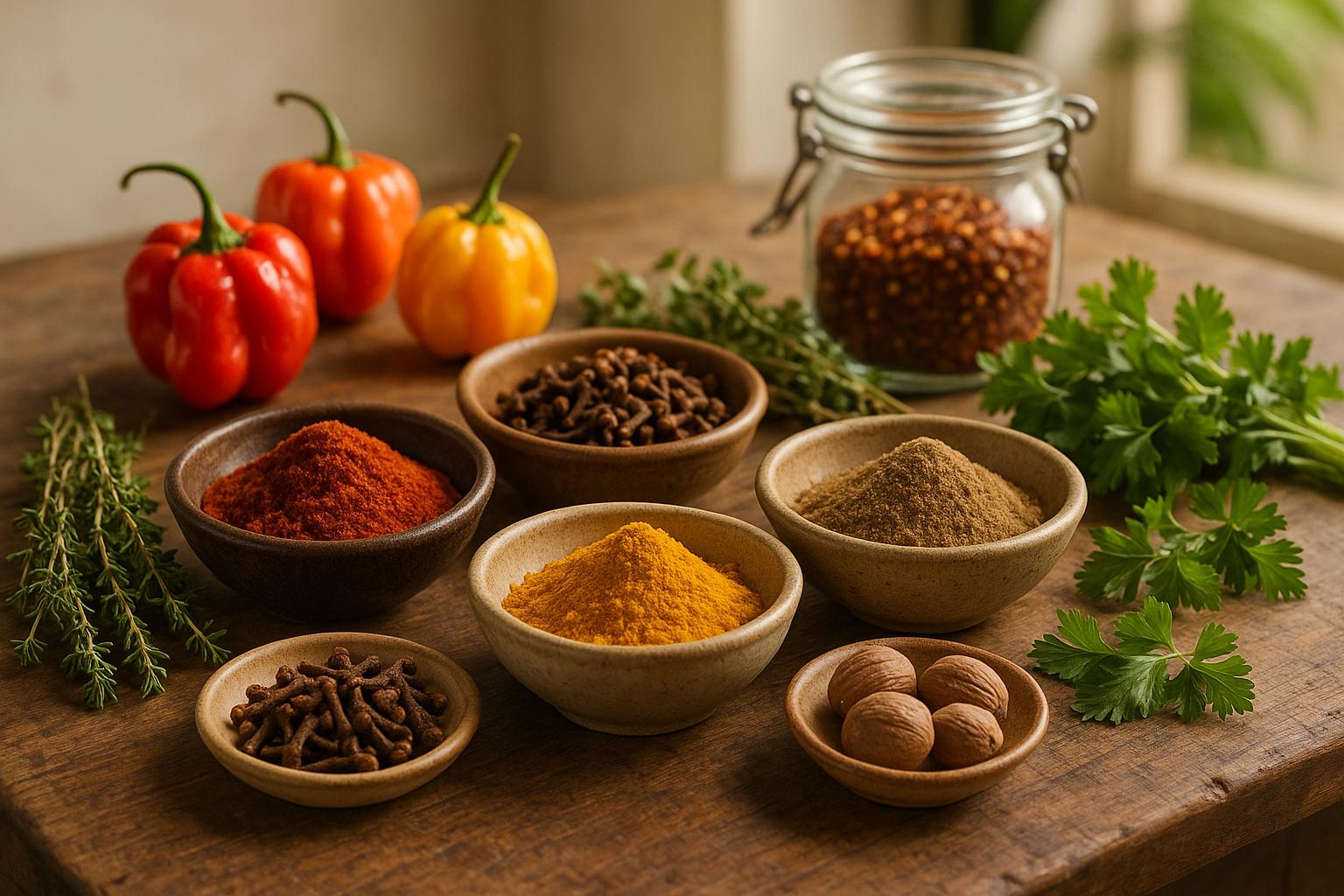Haitian spaghetti is a quick, flavorful dish you can make in just 20 minutes. It’s a bold twist on traditional spaghetti, featuring Haitian epis (a spice mix), smoked sausage or hot dogs, and a tangy tomato-based sauce with a hint of sweetness from ketchup. This dish is perfect for busy weeknights or as a hearty breakfast, a common tradition in Haiti.
Why You’ll Love This Recipe:
- Fast Cooking: Ready in just 20 minutes.
- Simple Ingredients: Uses pantry staples like spaghetti, tomato paste, and bouillon cubes.
- Bold Flavors: Haitian epis and caramelized tomato paste create a rich, aromatic base.
Key Steps:
- Cook the Pasta: Boil spaghetti to al dente and reserve pasta water.
- Prepare the Sauce: Sauté onions, bell peppers, and sausage. Add epis, tomato paste, and bouillon cubes.
- Combine: Toss pasta with the sauce, adjust consistency with pasta water, and serve.
Quick Tips:
- Use pre-made or store-bought Haitian epis to save time.
- Swap hot dogs for smoked sausage or kielbasa for a different flavor.
- Garnish with avocado, green onions, or parsley for a fresh finish.
Bring the vibrant taste of Haiti to your table tonight with this easy recipe!
HOW TO MAKE HAITIAN SPAGHETTI |EASY & DELICIOUS SPAGHETTI RECIPE
Ingredients for Haitian Spaghetti
This flavorful dish is built on simple pantry staples. Choosing the right ingredients is essential for creating Haitian spaghetti that bursts with bold flavors in just 20 minutes.
Core Ingredients
Start with thin spaghetti pasta - about 1 lb for four servings. Its quick cooking time and ability to soak up flavors make it perfect for this dish.
The standout component here is Haitian epis, a traditional seasoning blend that brings everything together. Made from scallions, fresh thyme, bell peppers, garlic, bouillon cubes, and ground cloves, this paste serves as the flavor-packed foundation of the recipe.
For protein, opt for smoked sausage or hot dogs. While Andouille sausage adds a smoky depth, regular hot dogs are a classic and budget-friendly choice. Use about 1/2 lb, sliced into rounds, for the perfect balance.
The sauce base calls for tomato paste (one 6 oz can), which caramelizes beautifully to create a rich, deep flavor. Add diced bell peppers and onions (one medium of each) for sweetness and texture. To enhance the savory notes, use bouillon cubes (Maggi is a popular choice) or a mix of Worcestershire and soy sauce. Lastly, a pinch of ground cloves adds a warm, distinctive touch that's quintessentially Haitian.
Pressed for time? Don’t worry - smart ingredient swaps can help you keep the dish authentic while saving effort.
Time-Saving Substitutions
Streamline your prep with a few handy substitutions. Pre-chopped frozen vegetables (like a bell pepper and onion mix) work just as well as fresh produce and cut down on chopping time. Pre-minced garlic from a jar is another time-saver, though fresh garlic offers a slightly brighter flavor. If fresh tomatoes aren’t available, canned diced tomatoes are a convenient alternative. You can even swap ketchup for tomato paste in a pinch - it provides a sweet tomato base that works surprisingly well. For thyme, dried works perfectly fine - just use about a third of the amount you would for fresh.
Ingredient Spotlight: Haitian Epis
At the heart of Haitian spaghetti is Haitian epis, a seasoning blend that’s a game-changer for flavor. This vibrant mix of peppers, garlic, and herbs is Haiti’s answer to Caribbean green seasoning or Latin American sofrito. It’s a staple in many Haitian dishes, lending its bold, aromatic flavors to everything from meats to vegetables.
What makes epis so special is its versatility. It can be used as a marinade, a base for stews, or even to elevate grilled dishes with its sweet and spicy notes. Whether you make it from scratch or buy it pre-made, it’s a must-have for authentic Haitian cooking. Homemade epis can last up to three months in the refrigerator, making it a great weekend project. When preparing it yourself, aim for a texture that’s not too smooth but not overly chunky either - just enough to spread evenly throughout your dish.
With these ingredients and tips, you’ll be well on your way to creating a delicious Haitian spaghetti that’s as easy to make as it is satisfying.
Step-by-Step Cooking Instructions
With your ingredients prepped and ready, it's time to bring everything together. Follow these steps to create your meal with ease.
Step 1: Cook the Pasta
Start by boiling a large pot of salted water. Add the thin spaghetti and give it a quick stir to prevent sticking. Keep an eye on the pasta and check it a little earlier than the package instructions to ensure it reaches that perfect al dente texture. As Meryl Feinstein from Pasta Social Club puts it, "Al dente pasta bites back. It has a satisfying texture and resistance; it's not mushy or gummy". Before draining, reserve 1 cup of the pasta water - this will help you adjust the sauce later. Drain the pasta right when it’s al dente, remembering it’ll continue cooking slightly when mixed with the sauce.
Step 2: Prepare the Sauce
While the pasta cooks, get started on the sauce. Heat a large skillet over medium-high heat and add 1–2 tablespoons of oil. Toss in the diced onions and bell peppers, letting them sauté for about 3–4 minutes until they begin to soften.
Next, add the sliced sausage or hot dogs to the skillet, allowing them to brown lightly. Stir in the Haitian epis, letting its aroma bloom for about 30 seconds. This step is key to achieving that authentic Haitian flavor - it’s irreplaceable.
Once the epis is fragrant, mix in the tomato paste and diced tomatoes. Add the crumbled bouillon cubes and stir everything together. Let the sauce simmer for 3–5 minutes until it thickens and comes together.
Step 3: Combine and Serve
When the sauce is ready, add the drained spaghetti directly into the skillet. Toss everything together until the pasta is evenly coated in the sauce. If the sauce feels too thick or dry, gradually stir in the reserved pasta water, a few tablespoons at a time, until you reach the consistency you want. Let the mixture simmer for another 1–2 minutes to meld the flavors.
Taste the dish and adjust the seasoning with salt, pepper, or more bouillon cubes if needed. Serve it hot and enjoy!
Tips for Better Flavor in Less Time
Creating restaurant-quality Haitian spaghetti in just 20 minutes is all about building flavor at every step. These three techniques will add depth and richness to your dish without taking up extra time.
Caramelizing Tomato Paste
Caramelizing tomato paste is a game-changer. Instead of tossing it straight into your sauce, take a few minutes to cook it down. This process intensifies the paste’s natural sweetness and adds a deeper, richer flavor to your dish.
Here’s how: Heat your skillet over medium heat, then add the tomato paste with a bit of oil, using a 2:1 ratio (two parts paste to one part oil). Stir it constantly for 3–5 minutes to prevent burning, and watch as the color shifts from bright red to a deep, rusty hue. Do this step after softening your onions and peppers but before adding diced tomatoes. It creates a flavorful base that sets the tone for the entire dish.
Using Bouillon Cubes Effectively
Bouillon cubes are a cornerstone of Haitian cooking. There’s even a saying: "Maggi nan tout sòs," or "Maggi is in every sauce". To make the most of this ingredient, dissolve one bouillon cube in 2–3 tablespoons of hot pasta water before stirring it into your sauce. This ensures the flavor spreads evenly and avoids any gritty texture.
Since bouillon cubes are naturally salty, be sure to taste your sauce before adding extra salt. This step will help you achieve that signature savory kick without overdoing it. For the final touch, enhance your sauce with a quick homemade epis.
Quick Homemade Epis
Nothing beats the freshness of homemade Haitian epis. It’s a simple blend of herbs and aromatics that adds a burst of flavor to your dish. To make a quick batch, combine these ingredients in a food processor:
- 1 small onion, quartered
- 1 bell pepper, chopped
- 2 scallions
- 3 garlic cloves
- A handful of fresh parsley
- 1 tablespoon fresh thyme
- 1 tablespoon olive oil
- 1 teaspoon lime juice
Pulse the mixture just enough to keep some texture - you don’t want a completely smooth paste. The vegetables already have plenty of moisture, so there’s no need to add water. Store your epis in the fridge for up to 5 days, or freeze it in ice cube trays for easy use later.
sbb-itb-80c33ff
Serving and Presentation
Haitian spaghetti is a feast for both the eyes and the palate, making it a standout at family gatherings. Its vibrant colors and bold flavors deserve a presentation that truly does it justice. Once you've completed your quick 20-minute journey to this flavorful dish, the final touch lies in how you serve it.
How to Plate the Dish
After mixing the pasta with the sauce, take care to plate it in a way that highlights its colorful ingredients. Twirl a generous portion of spaghetti into a neat mound on your plate, ensuring the bright vegetables and proteins - like tomatoes, bell peppers, and onions - are visible.
For a traditional Haitian touch, add a few slices of avocado fanned out beside the pasta. Halved hard-boiled eggs not only boost the visual appeal but also add extra protein. Pair the dish with a warm baguette or a slice of crusty bread to complete the classic presentation.
To give the dish a polished finish, sprinkle sliced green onions on top for a pop of color and a mild onion flavor. A touch of freshly chopped parsley adds a vibrant green accent that contrasts beautifully with the rich red sauce. These simple garnishes elevate the dish, making it look like something straight out of a restaurant kitchen.
For an even heartier meal, Mika's Table suggests serving Haitian spaghetti with herring. Pair it with a fresh green salad tossed in a light vinaigrette, fried or boiled plantains, or more crusty bread for a well-rounded spread that’s sure to impress.
Adaptations for US Ingredients
Bringing Haitian spaghetti to American kitchens doesn’t mean losing its authenticity. With a few thoughtful ingredient swaps, you can create a version that’s both true to its roots and tailored to local tastes. For instance, replace hot dogs with beef kielbasa or smoked sausage. If you prefer a milder heat, poblano or bell peppers make excellent substitutes.
Want to switch things up even more? You can experiment with different proteins or skip the meat altogether for a vegetarian twist. Regardless of the changes, the dish's vibrant vegetables, aromatic sauce, and carefully chosen garnishes ensure it remains visually appealing and full of flavor. These adaptations allow you to enjoy Haitian spaghetti in a way that feels authentic while fitting seamlessly into your own kitchen.
Explore More Haitian Cuisine on HaitianFoods.org

Now that you've mastered this quick and flavorful 20-minute Haitian spaghetti recipe, why not dive deeper into the world of Haitian cuisine? HaitianFoods.org is your go-to resource for a treasure trove of recipes, cultural stories, and culinary tips that can take your cooking to the next level. From hearty stews to iconic rice dishes, the blog is packed with recipes and insights to expand your culinary repertoire.
Some standout recipes include Poul Nan Sos (Haitian Chicken Stew), Diri Djon Djon (black mushroom rice), and Griot (marinated and fried pork). Each recipe is thoughtfully curated with prep times and difficulty levels, making it easy to whip up authentic meals in as little as 30–45 minutes - perfect for busy weeknights.
"Haitian food combines unique flavors, fresh local ingredients, and rich cultural history." - HaitianFoods.org
Haitian cuisine is a vibrant blend of African, French, and Taíno influences, resulting in dishes that feel both exotic and approachable to American taste buds. For example, the tradition of enjoying spaghetti for breakfast - often paired with hot dogs or smoked herring and seasoned with a signature spice blend - reflects this fascinating fusion of cultures.
Find Haitian Ingredients Near You
Tracking down authentic Haitian ingredients doesn't have to be a hassle, even if you're in the U.S. HaitianFoods.org offers a handy directory of markets and stores where you can find essentials like epis (a Haitian seasoning base), scotch bonnet peppers, and other specialty items. These resources make it easier to bring the true flavors of Haiti into your home kitchen.
Even if some ingredients aren't readily available, many Haitian dishes can be recreated with substitutes you’ll find at your local grocery store. Haitian cooking is rooted in bold spices, aromatic herbs, and staples like rice, beans, and plantains, so you can still capture the essence of the cuisine with a little creativity.
Learn About Haitian Food History
Cooking Haitian food isn’t just about the ingredients - it's also about the stories behind them. HaitianFoods.org dives into the rich history of traditional recipes, exploring how certain spice blends became staples and the cultural significance of key ingredients. For instance, Diri Djon Djon, a signature rice dish, gets its striking black color and earthy flavor from djon djon mushrooms, a beloved ingredient in Haitian households.
Conclusion: Bringing Haiti to Your Table in 20 Minutes
Creating Haitian spaghetti in just 20 minutes is all about focusing on the essential steps that define this cherished dish. The magic lies in a few key techniques: incorporating Haitian epis, cooking pasta to a perfect al dente, and caramelizing tomato paste for depth of flavor.
By following these steps, simple ingredients transform into something extraordinary. Quickly sautéing onions, garlic, and peppers builds a flavorful base, while adding a whole scotch bonnet pepper brings just the right amount of heat. A splash of reserved pasta water ensures the sauce clings beautifully to every strand, creating a silky, satisfying finish.
This dish’s versatility makes it a go-to for busy families. At around 446 calories per serving, it’s a hearty, comforting meal that easily adapts to whatever you have on hand - be it chicken, vegetables, or sausage. Plus, it stores well for a few days, making it perfect for meal prep or those nights when time is short but flavor is still a priority.
With this quick and flavorful recipe, you can bring the essence of Haitian cuisine to your table. Techniques like using bouillon powder and a brief simmering time capture the bold and aromatic flavors that define this dish, while keeping it practical for weeknight dinners. Whether you're revisiting a familiar favorite or introducing your family to something new, Haitian spaghetti delivers a taste of Haiti’s culinary heritage in a way that fits seamlessly into your busy life.
FAQs
What is Haitian epis, and how do I make it at home?
Haitian Epis: The Heart of Haitian Cuisine
Haitian epis is a fragrant and versatile seasoning blend that's the backbone of many Haitian recipes. This vibrant mix of fresh herbs, garlic, peppers, and other ingredients is used to elevate the flavors of soups, stews, marinades, and more. It's a must-have in Haitian kitchens, bringing a punchy, zesty kick to every meal.
Want to make Haitian epis at home? Here's how: Combine 1 cup of parsley, 1/2 cup of scallions, 1/2 cup of fresh thyme, 8 garlic cloves, 1 green bell pepper, 1 red bell pepper, and a splash of vinegar or lime juice in a blender. For some added heat, toss in a Scotch bonnet pepper. Blend until smooth, adjusting the consistency with olive oil if needed. Store your epis in an airtight container in the refrigerator, and you'll have a flavorful seasoning ready to use for weeks. It’s the perfect way to bring authentic Haitian flavors to your kitchen!
Can I use different types of pasta to make Haitian spaghetti?
When making Haitian spaghetti, you can experiment with various types of pasta, like linguine, vermicelli, or even fettuccine. Just be cautious with thinner options, such as angel hair, as they tend to cook faster and might turn mushy, altering the dish's texture. To get the best outcome, choose sturdier pastas that can stand up to the hearty sauce and bold flavors that define Haitian spaghetti.
What are some vegetarian options for the protein in Haitian spaghetti?
If you're exploring vegetarian options for Haitian spaghetti, there are some tasty ways to keep the dish flavorful and satisfying. Plant-based sausages made from soy, seitan, or other meat alternatives work well in place of the traditional hot dogs or sausages. They deliver a similar texture and savory taste that complements the dish beautifully.
Another option is to skip the meat altogether and focus on the bold tomato sauce, aromatic spices, and vibrant vegetables. This approach lets the natural flavors take center stage, creating a hearty, vegetarian-friendly version of Haitian spaghetti that's perfect for a quick and delicious meal.


